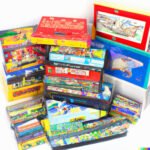Introduction
The 1980s and 1990s were a golden age for board games. For decades, these classics had been staples in many people’s homes, offering an interactive, often quirky way to spend time with friends and family. But the 80s and 90s brought a resurgence of popularity as new and innovative games hit store shelves. From classic favorites like Monopoly and Clue to timeless hits like Trivial Pursuit and Mousetrap, there was something for everyone. People of all ages, from toddlers to grandparents, could enjoy playing board games together.
These years also marked the introduction of more sophisticated strategy games like Risk, Scrabble, Sorry!, Carcassonne, Boggle, Settlers of Catan and countless others. These beloved pastimes challenged players to think ahead and out smart their opponents in order to win. Even those who weren’t into classic gaming had access to popular titles that used pop culture references or focused on topics like sports trivia or exploring the night sky with Astronomy! Board games were so popular during this period that themed versions using characters from movies (like Star Wars Monopoly) or TV shows (like The Simpsons Scene-It!) became big hits at parties.
For many of us today who grew up in the 80’s and 90’s, playing board games was a cherished part of childhood which holds many fond memories. Revisiting these classic favorites can let us reminisce on the past while introducing them to our own children will keep their memories alive even longer. Nothing beats getting together with friends or loved ones around a physical game ” it puts away screens allowing you to connect with each other in an intimate setting where laughter is the only goal! So dust off your favorite game pieces! It’s time for another round!
Classic Board Games
The 1980s and 1990s were filled with some of the most popular board games ever created. While some of these classic titles still exist today, many of them were only brought to market during this era and have since been discontinued.
One iconic game from this period was Trivial Pursuit. This game featured a unique concept where players answer questions about six different categories in order to win. Players accumulate points for each correct answer, and must reach the center of the board first in order to win. It was released in the early 80’s and is still produced today.
Interestingly, Risk was first published in France over fifty years prior to its boom in popularity during the 80’s and 90’s. The game requires strategic decision-making as players attempt to manipulate a global map populated by valuable armies from either side; adding an element of chance keeps rounds engaging even after decades of playtime!
Popular auction game, Monopoly, was invented during the early 20th century but saw widespread popularity with its release on Nintendo consoles during the mid 80’s – shortly after which editions flooded retail stores worldwide! Monopoly is a classic example of two prominent mechanics frequently used amongst games of economic status like Capitalism or Business Acquisition; involving trading cards that allow players to purchase land pieces, build houses/hotels then earn varying amounts depending on all properties owned at any given time throughout playtime
Another incredibly thrilling card-based game, Uno, took cabinets around family dining rooms internationally by storm when it underwent an increase in production following several successful expansions. Filled with team dynamics indicating special abilities with specific cards adding a layer of unexpected surprises even amongst those who have grown familiarized with gameplay throughout childhood or further adult years!
In conclusion – though packaged differently throughout their respective release eras thus contributing to their period-specific designs – titles like Trivial Pursuit, Risk, Monopoly & Uno remain timeless classics that can host interactive experiences just as sought-after today as they were 30+ years ago!
Game Genre the details
Card Games – These games include classics like Uno, Phase 10, and Yatzee. Players try to match cards according their value and features, collect runs of consecutive numbers, match colors, or fulfill other specific requirements. Most often the games rely on players drawing a card from a well-shuffled deck in order to succeed.
Dice Games – These are classics like Sorry!, Parcheesi, and Monopoly. They involve rolling dice to determine the amount of spaces which can be moved on the game board. In some cases, players need to throw a certain number or combination of numbers in order to succeed. Many competitive versions also use blocking pieces so that opponents can be blocked from certain spaces or actions.
Role-Playing Games – Role-playing games such as Dungeons & Dragons require players to create a character before playing and set out on adventures with fellow adventurers. This can range from exploring dungeons or solving riddles to battling monsters or rival forces. New mechanics for these types of games during this era included innovations like tactical combat for battles rather than simply managing stats and characteristics of characters encountering one another.
Party & Trivia Games – Party and trivia games continued to grow during this time period providing an entertainment option for groups of people looking for something new and exciting to do without leaving the house. Popular party board game releases included Buzzword (where teams competed against each other by guessing words related to clues), Pictionary (a popular game that was later digitized), Twister (the classic game still played by people today), Boggle (a word game where players compete against each other to spell words) and who can forget Clue ” the popular whodunit murder mystery game?
Fun Facts & Traditions
During the 80s and 90s, board games held a prominent place in family night entertainment. From classics like Monopoly, to newcomers such as Trivial Pursuit, poker nights were elevated by an array of strategic, addicting games. It’s no surprise that certain rules or stories from these classic board games have carried through the generations – from the infamous “Go directly to jail” card in Monopoly to the long speculated secrets of Operation.
Other interesting traditions involving board games have also been popularized. For example, many people understand that when playing Scrabble it is bad luck to shuffle your letters on the board as it will bring harm upon you and your game points!
In addition, many 80s and 90s favorites have been modernized over time. They’ve become more current with sociocultural themes and improved product designs while maintaining the same core elements of strategy that made these board games so beloved by game players across time.
The enduring Legacy
The 80’s and 90’s board games remain a phenomenon and a cult classic around the world. These board games have changed the gaming industry, and generations of board game players are still enjoying them today. From Scrabble to Trivial Pursuit, these iconic and beloved tabletop games have captivated millions of gamers for decades.
It could be argued that the enduring legacy of 80s and 90s board games expands beyond just bringing people together for game night. The fact that these timeless games are still incredibly popular in 2020 speaks to the quality, intelligence, and complexity they require of their players. Moreover, it is clear that they remain amongst popular culture’s most successful products throughout numerous years.
Interestingly enough, many of these vintage board games have been revised or upgraded to attract younger crowds as well as veteran fans. Monopoly has undergone numerous changes since its inception in 1933 such as updating currency amounts to match current trends, changing up house rules, or coming out with different themed versions like Friends Edition or Star Wars Edition provide an enticing twist on a classic favorite. Similarly, classics like Battleship have been given makeovers by introducing updated technology into gameplay such as augmented reality apps resembling modern video game experiences.
In summary, it must be said that these enduring 80’s and 90’s board games remain firmly entrenched within pop culture due to their legacy on gaming history completed with multiple revisions, spin-offs and adaptations producing new ways for fans young and old alike connecting over a classic title making them timeless favorites down through the ages.
Final Thoughts
The 80s and 90s were a golden era of board games. Not only were they popular in their own right but they often served as the common thread that connected us to our family and friends, creating lasting memories and bonds that can still be felt today. Board games such as Monopoly, Clue, Risk, and Battleship filled our shelves and reminded us of what Saturday nights were all about ” spending quality time with loved ones.
These classic games remain beloved today due not only to their replayability but also for the non-digital form of entertainment and nostalgia value. Many have been revitalised for modern times or recreated almost exactly as they are remembered in new versions – from virtual reality to tabletop editions. Our shared experience via social media also makes it easier than ever for people to reminisce on these titles no matter where they are from.
At their essence plays like these define our notion of fun, implying skillful strategy through the chance element and teaching life lessons along the way. With so many pros for children and adults alike, challenges that require cooperation, communication and camaraderie ” it’s clear why these board games continue to shape peoples childhoods (and adult relationships) throughout different generations. They will remain an integral part of how we relax at home, enjoy ourselves in linear pursuits, or venture off on imaginative quests together until something else comes along which fills this unique niche better than before.

I love playing all kinds of games – from classics like Monopoly to modern favourites like Ticket to Ride.
I created this blog as a way to share my love of board games with others, and provide information on the latest releases and news in the industry.





